In the diverse landscape of K12 education, the age-old question of lectures, attention, and self-study often puzzles students. Should they prioritize attending every lecture or carve out more time for self-directed learning? This is a crucial decision that can significantly impact their academic journey.

The Value of Classroom Lectures
Classroom lectures play a vital role in K12 education. Firstly, they provide a structured learning environment. Teachers are able to present information in a logical sequence, making it easier for students to understand complex concepts. For example, in a science class, a teacher can demonstrate experiments step by step, explaining the underlying principles at each stage. According to Education.com, this kind of in-person interaction helps students stay focused and engaged.
In addition, lectures offer immediate feedback. Students can ask questions on the spot and get instant answers from their teachers. This real-time interaction enhances understanding and clears up any misunderstandings promptly.

The Power of Self-Study
Self-study, on the other hand, allows students to learn at their own pace. Some students may grasp certain concepts quickly and prefer to move ahead, while others might need more time to absorb information. With self-study, they have the flexibility to allocate time according to their individual needs. As stated on Psychology Today, self-directed learning can also boost independence and self-discipline.
Moreover, self-study encourages exploration. Students can delve deeper into topics that interest them, going beyond the curriculum. They can explore different resources, such as online articles, documentaries, and e-books, which can broaden their knowledge base.
Finding the Right Balance
To find the optimal balance between lectures and self-study, students should first understand their learning style. Visual learners might benefit more from lectures with visual aids, while auditory learners could thrive in lecture settings with engaging discussions. Once they identify their style, they can allocate time accordingly. For instance, if a student is a visual learner, they could spend more time creating mind maps during self-study to reinforce what they’ve learned in lectures.
Another important aspect is setting clear goals. Whether it’s mastering a particular subject or preparing for an exam, having clear goals will help students determine how much time to spend on lectures and self-study. They can break down their goals into smaller tasks and schedule time for each, ensuring a balanced approach.
Readability guidance: This article has presented the advantages of lectures and self-study, along with practical tips on finding the right balance. By understanding their learning style and setting clear goals, K12 students can make the most of both lecture attendance and self-study, enhancing their overall learning experience.


